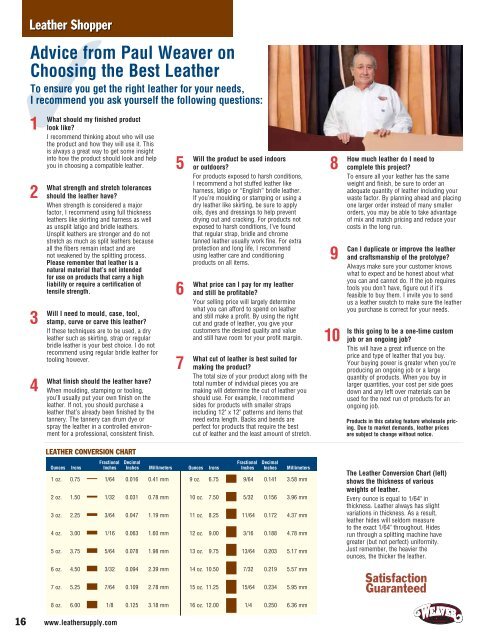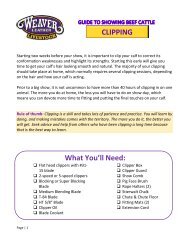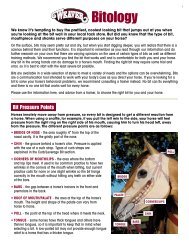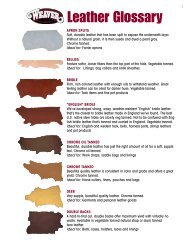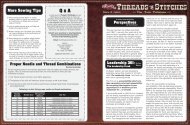2 - Weaver Leather
2 - Weaver Leather
2 - Weaver Leather
You also want an ePaper? Increase the reach of your titles
YUMPU automatically turns print PDFs into web optimized ePapers that Google loves.
<strong>Leather</strong> Shopper<br />
31<br />
Advice from Paul <strong>Weaver</strong> on<br />
Choosing the Best <strong>Leather</strong><br />
To ensure you get the right leather for your needs,<br />
I recommend you ask yourself the following questions:<br />
2<br />
3<br />
4<br />
What should my finished product<br />
look like?<br />
I recommend thinking about who will use<br />
the product and how they will use it. This<br />
is always a great way to get some insight<br />
into how the product should look and help<br />
you in choosing a compatible leather.<br />
What strength and stretch tolerances<br />
should the leather have?<br />
When strength is considered a major<br />
factor, I recommend using full thickness<br />
leathers like skirting and harness as well<br />
as unsplit latigo and bridle leathers.<br />
Unsplit leathers are stronger and do not<br />
stretch as much as split leathers because<br />
all the fibers remain intact and are<br />
not weakened by the splitting process.<br />
Please remember that leather is a<br />
natural material that’s not intended<br />
for use on products that carry a high<br />
liability or require a certification of<br />
tensile strength.<br />
Will I need to mould, case, tool,<br />
stamp, curve or carve this leather?<br />
If these techniques are to be used, a dry<br />
leather such as skirting, strap or regular<br />
bridle leather is your best choice. I do not<br />
recommend using regular bridle leather for<br />
tooling however.<br />
What finish should the leather have?<br />
When moulding, stamping or tooling,<br />
you’ll usually put your own finish on the<br />
leather. If not, you should purchase a<br />
leather that’s already been finished by the<br />
tannery. The tannery can drum dye or<br />
spray the leather in a controlled environment<br />
for a professional, consistent finish.<br />
5<br />
6<br />
7<br />
Will the product be used indoors<br />
or outdoors?<br />
For products exposed to harsh conditions,<br />
I recommend a hot stuffed leather like<br />
harness, latigo or “English” bridle leather.<br />
If you’re moulding or stamping or using a<br />
dry leather like skirting, be sure to apply<br />
oils, dyes and dressings to help prevent<br />
drying out and cracking. For products not<br />
exposed to harsh conditions, I’ve found<br />
that regular strap, bridle and chrome<br />
tanned leather usually work fine. For extra<br />
protection and long life, I recommend<br />
using leather care and conditioning<br />
products on all items.<br />
What price can I pay for my leather<br />
and still be profitable?<br />
Your selling price will largely determine<br />
what you can afford to spend on leather<br />
and still make a profit. By using the right<br />
cut and grade of leather, you give your<br />
customers the desired quality and value<br />
and still have room for your profit margin.<br />
What cut of leather is best suited for<br />
making the product?<br />
The total size of your product along with the<br />
total number of individual pieces you are<br />
making will determine the cut of leather you<br />
should use. For example, I recommend<br />
sides for products with smaller straps<br />
including 12" x 12" patterns and items that<br />
need extra length. Backs and bends are<br />
perfect for products that require the best<br />
cut of leather and the least amount of stretch.<br />
8<br />
9<br />
10<br />
How much leather do I need to<br />
complete this project?<br />
To ensure all your leather has the same<br />
weight and finish, be sure to order an<br />
adequate quantity of leather including your<br />
waste factor. By planning ahead and placing<br />
one larger order instead of many smaller<br />
orders, you may be able to take advantage<br />
of mix and match pricing and reduce your<br />
costs in the long run.<br />
Can I duplicate or improve the leather<br />
and craftsmanship of the prototype?<br />
Always make sure your customer knows<br />
what to expect and be honest about what<br />
you can and cannot do. If the job requires<br />
tools you don’t have, figure out if it’s<br />
feasible to buy them. I invite you to send<br />
us a leather swatch to make sure the leather<br />
you purchase is correct for your needs.<br />
Is this going to be a one-time custom<br />
job or an ongoing job?<br />
This will have a great influence on the<br />
price and type of leather that you buy.<br />
Your buying power is greater when you’re<br />
producing an ongoing job or a large<br />
quantity of products. When you buy in<br />
larger quantities, your cost per side goes<br />
down and any left over materials can be<br />
used for the next run of products for an<br />
ongoing job.<br />
Products in this catalog feature wholesale pricing.<br />
Due to market demands, leather prices<br />
are subject to change without notice.<br />
LEATHER CONVERSION CHART<br />
®<br />
Fractional Decimal<br />
Ounces Irons Inches Inches Millimeters<br />
1 oz. 0.75 1/64 0.016 0.41 mm<br />
2 oz. 1.50 1/32 0.031 0.78 mm<br />
3 oz. 2.25 3/64 0.047 1.19 mm<br />
4 oz. 3.00 1/16 0.063 1.60 mm<br />
5 oz. 3.75 5/64 0.078 1.98 mm<br />
Fractional Decimal<br />
Ounces Irons Inches Inches Millimeters<br />
9 oz. 6.75 9/64 0.141 3.58 mm<br />
10 oz. 7.50 5/32 0.156 3.96 mm<br />
11 oz. 8.25 11/64 0.172 4.37 mm<br />
12 oz. 9.00 3/16 0.188 4.78 mm<br />
13 oz. 9.75 13/64 0.203 5.17 mm<br />
The <strong>Leather</strong> Conversion Chart (left)<br />
shows the thickness of various<br />
weights of leather.<br />
Every ounce is equal to 1/64" in<br />
thickness. <strong>Leather</strong> always has slight<br />
variations in thickness. As a result,<br />
leather hides will seldom measure<br />
to the exact 1/64" throughout. Hides<br />
run through a splitting machine have<br />
greater (but not perfect) uniformity.<br />
Just remember, the heavier the<br />
ounces, the thicker the leather.<br />
®<br />
6 oz. 4.50 3/32 0.094 2.39 mm<br />
7 oz. 5.25 7/64 0.109 2.78 mm<br />
14 oz. 10.50 7/32 0.219 5.57 mm<br />
15 oz. 11.25 15/64 0.234 5.95 mm<br />
Satisfaction<br />
Guaranteed<br />
®<br />
8 oz. 6.00 1/8 0.125 3.18 mm<br />
16 oz. 12.00 1/4 0.250 6.36 mm<br />
16<br />
www.leathersupply.com<br />
®


